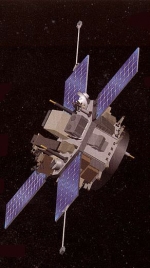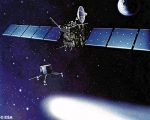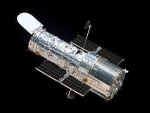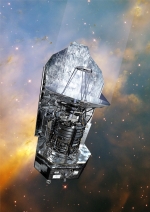Displaying items by tag: spacecraft
BOEING
Boeing is the world's largest aerospace company and leading manufacturer of commercial jetliners and defense, space and security systems. A top U.S. exporter, the company supports airlines and U.S. and allied government customers in 150 countries. Boeing products and tailored services include commercial and military aircraft, satellites, weapons, electronic and defense systems, launch systems, advanced information and communication systems, and performance-based logistics and training.
Boeing has a long tradition of aerospace leadership and innovation. The company continues to expand its product line and services to meet emerging customer needs. Its broad range of capabilities includes creating new, more efficient members of its commercial airplane family; integrating military platforms, defense systems and the warfighter through network-enabled solutions; creating advanced technology solutions; and arranging innovative customer-financing options.
With corporate offices in Chicago, Boeing employs more than 170,000 people across the United States and in 70 countries. This represents one of the most diverse, talented and innovative workforces anywhere. More than 140,000 employees hold college degrees -- including nearly 35,000 advanced degrees -- in virtually every business and technical field from approximately 2,700 colleges and universities worldwide. Our enterprise also leverages the talents of hundreds of thousands more skilled people working for Boeing suppliers worldwide.
Boeing is organized into two business units: Boeing Commercial Airplanes and Boeing Defense, Space & Security. Supporting these units are Boeing Capital Corporation, a global provider of financing solutions; the Shared Services Group, which provides a broad range of services to Boeing worldwide; and Boeing Engineering, Operations & Technology, which helps develop, acquire, apply and protect innovative technologies and processes.
Boeing Commercial Airplanes
Boeing has been the premier manufacturer of commercial jetliners for more than 40 years. With the merger of Boeing and McDonnell Douglas in 1997, Boeing's leadership in commercial jets, joined with the lineage of Douglas airplanes, gives the combined company a 70-year heritage of leadership in commercial aviation. Today, the main commercial products are the 737, 747, 767 and 777 families of airplanes and the Boeing Business Jet. New product development efforts are focused on the Boeing 787 Dreamliner, and the 747-8. The company has nearly 12,000 commercial jetliners in service worldwide, which is roughly 75 percent of the world fleet. Through Boeing Commercial Aviation Services, the company provides unsurpassed, around-the-clock technical support to help operators maintain their airplanes in peak operating condition. Commercial Aviation Services offers a full range of world-class engineering, modification, logistics and information services to its global customer base, which includes the world's passenger and cargo airlines, as well as maintenance, repair and overhaul facilities. Boeing also trains maintenance and flight crews in the 100-seat-and-above airliner market through Boeing Training & Flight Services, the world's largest and most comprehensive provider of airline training.
Boeing Defense, Space & Security (BDS)
Boeing Defense, Space & Security (BDS) provides end-to-end services for large-scale systems that enhance air-, land-, sea- and space-based platforms for global military, government and commercial customers. In addition to designing, producing, modifying and supporting fighters, bombers, transports, rotorcraft, aerial refuelers, missiles, munitions and spacecraft for military, civil and commercial use, BDS is developing enhanced capabilities through network-enabled solutions, communications and intelligence, surveillance and reconnaissance technologies. BDS supports the U.S. government as a system integrator on several programs of national significance, including NASA's International Space Station and, the Missile Defense Agency's Ground-based Midcourse Defense program. BDS is also expanding into new markets and adjacencies, including unmanned systems, cyber security, energy management, and support and logistics.
Boeing Capital Corporation
Boeing Capital Corporation is a global provider of financing solutions. Working closely with Commercial Airplanes and Defense, Space & Security, Boeing Capital Corporation arranges, structures and provides financing to facilitate the sale and delivery of Boeing commercial and military products. With a year end 2011 portfolio value at approximately $4.3 billion, Boeing Capital Corporation combines Boeing's financial strength and global reach, detailed knowledge of Boeing customers and equipment, and the expertise of a seasoned group of financial professionals.
Engineering, Operations & Technology
EO&T enhances Boeing's growth and productivity by driving technical and functional excellence across the enterprise. Its primary objectives are to support the company's business units by delivering high-quality, low-cost technical services in information technology, research and technology, and test and evaluation; integrated enterprise strategies that ensure technology is ready when needed, competitively protected and environmentally progressive; and highly disciplined and efficient engineering, operations and supplier management support that ensures program success. The organization pays particular attention to ensuring the success of development programs, and strives to attract, develop and retain a world-class technical and functional work force.
Shared Services Group
Shared Services Group allows business units to focus on profitable growth by providing the infrastructure services required to run their global operations. The group provides a broad range of services worldwide, including facilities services, employee benefits and services, staffing, recruitment, wellness programs, security, fire protection, site operations, disaster preparedness, construction, reclamation, conservation programs, virtual workplace, creative services, transportation, business continuity and the purchase of all non-production goods and services. It also offers comprehensive travel services to Boeing employees and manages the sale and acquisition of all leased and owned property for Boeing. By integrating services, Shared Services Group delivers greater value, creates "lean" processes and operations, leverages buying power and simplifies access to services for all of Boeing.
Kibo (ISS module)
The Japanese Experiment Module (JEM), also known with the nickname Kibo (きぼう Kibō, Hope), is a Japanese science module for the International Space Station (ISS) developed by JAXA.
It is the largest single ISS module. The first two pieces of the module were launched on space shuttle missions STS-123 and STS-124. The third and final components were launched on STS-127.
Mars Express
Mars Express is a space exploration mission being conducted by the European Space Agency (ESA). The Mars Express mission is exploring the planet Mars, and is the first planetary mission attempted by the agency. "Express" originally referred to the speed and efficiency with which the spacecraft was designed and built.However "Express" also describes the spacecraft's relatively short interplanetary voyage, a result of being launched when the orbits of Earth and Mars brought them closer than they had been in about 60,000 years.
Mars Express consists of two parts, the Mars Express Orbiter and the Beagle 2, a lander designed to perform exobiology and geochemistry research. Although the lander failed to land safely on the Martian surface, the Orbiter has been successfully performing scientific measurements since early 2004, namely, high-resolution imaging and mineralogical mapping of the surface, radar sounding of the subsurface structure down to the permafrost, precise determination of the atmospheric circulation and composition, and study of the interaction of the atmosphere with the interplanetary medium.
Due to the valuable science return and the highly flexible mission profile, Mars Express has been granted five mission extensions, the latest until 2014.
Some of the instruments on the orbiter, including the camera systems and some spectrometers, reuse designs from the failed launch of the Russian Mars 96 mission in 1996 (European countries had provided much of the instrumentation and financing for that unsuccessful mission). The basic design of Mars Express is based on ESA's Rosetta mission, on which a considerable sum was spent on development. The same design was also used for the Venus Express mission in order to increase reliability and reduce development cost and time.
ACE (spacecraft)
Advanced Composition Explorer (ACE) is a NASA space exploration mission being conducted as part of the Explorer program to study matter in situ, comprising energetic particles from the solar wind, the interplanetary medium, and other sources. Real-time data from ACE is used by the Space Weather Prediction Center to improve forecasts and warnings of solar storms. The ACE robotic spacecraft was launched August 25, 1997 and is currently operating in a Lissajous orbit close to the L1 Lagrange point (which lies between the Sun and the Earth at a distance of some 1.5 million km from the latter). The spacecraft is still in generally good condition, and has enough fuel to maintain its orbit until 2024. NASA Goddard Space Flight Center managed the development and integration of the ACE spacecraft.
Instrumentation
- Cosmic Ray Isotope Spectrometer (CRIS): CRIS determines the isotope composition of galactic cosmic rays. It is designed to be sensitive enough to detect isotopes up to the range of zinc (Z-30).
- ACE Real Time Solar Wind (RTSW).
- Solar Wind Ion Mass Spectrometer (SWIMS) and Solar Wind Ion Composition Spectrometer (SWICS): These two instruments are time-of-flight mass spectrometers, each tuned for a different set of measurements. They analyze the chemical and isotopic composition of solar wind and interstellar matter.
- Ultra-Low Energy Isotope Spectrometer (ULEIS): ULEIS measures ion flux and is sensitive to a range from helium through nickel to determine the makeup of solar energetic particles and the mechanism by which the particles become charged by the sun.
- Solar Energetic Particle Ionic Charge Analyzer (SEPICA): As of 2008, this instrument is no longer functioning due to failed gas valves.
- Solar Isotope Spectrometer (SIS).
- Solar Wind Electron, Proton and Alpha Monitor (SWEPAM).
- Electron, Proton, and Alpha-particle Monitor (EPAM).
- Magnetometer (MAG).
Rosetta spacecraft
Rosetta is a robotic spacecraft of the European Space Agency on a mission to study the comet 67P/Churyumov–Gerasimenko. Rosetta consists of two main elements:
- the Rosetta space probe;
- the Philae lander.
The spacecraft was launched on 2 March 2004 on an Ariane 5 rocket and will reach the comet by mid 2014. The space probe is intended to orbit and perform long-term exploration of the comet at close quarters. On 10 November 2014 the Philae lander will attempt to land and perform detailed investigations on the comet's surface. Both the probe and the lander carry a large complement of scientific experiments designed to complete the most detailed study of a comet ever attempted.
The probe is named after the Rosetta Stone, as it is hoped the mission will help form an idea of how the solar system looked before planets formed. The lander is named after the Nile island Philae where an obelisk was found that helped decipher the Rosetta Stone. The spacecraft has already performed two successful asteroid flyby missions on its way to the comet. In 2007 performed a Mars swingby (flyby), and returned images. The craft completed its fly-by of asteroid 2867 Šteins in September 2008 and of 21 Lutetia in July 2010, and is presently (2013) in hibernation and on-target for its final destination as of June 2013.
Hubble Space Telescope
The Hubble Space Telescope (HST) is a space telescope that was carried into orbit by a Space Shuttle in 1990 and remains in operation. A 2.4 meter (7.9 ft) aperture telescope in low Earth orbit, Hubble's four main instruments observe in the near ultraviolet, visible, and near infrared. The telescope is named after the astronomer Edwin Hubble.
Hubble's orbit outside the distortion of Earth's atmosphere allows it to take extremely sharp images with almost no background light. Hubble's Ultra-Deep Field image, for instance, is the most detailed visible-light image ever made of the universe's most distant objects. Many Hubble observations have led to breakthroughs in astrophysics, such as accurately determining the rate of expansion of the universe.
Although not the first space telescope, Hubble is one of the largest and most versatile, and is well known as both a vital research tool and a public relations boon for astronomy. The HST was built by the United States space agency NASA, with contributions from the European Space Agency, and is operated by the Space Telescope Science Institute. The HST is one of NASA's Great Observatories, along with the Compton Gamma Ray Observatory, the Chandra X-ray Observatory, and the Spitzer Space Telescope.
Space telescopes were proposed as early as 1923. Hubble was funded in the 1970s, with a proposed launch in 1983, but the project was beset by technical delays, budget problems, and the Challenger disaster. When finally launched in 1990, scientists found that the main mirror had been ground incorrectly, significantly compromising the telescope's capabilities. However, after a servicing mission in 1993, the telescope was restored to its intended quality.
Hubble is the only telescope designed to be serviced in space by astronauts. Between 1993 and 2002, four missions repaired, upgraded, and replaced systems on the telescope, but a fifth mission was canceled on safety grounds following the Columbia disaster. However, after spirited public discussion, NASA administrator Mike Griffin approved one final servicing mission, completed in 2009. The telescope is now expected to function until at least 2014. Its scientific successor, the James Webb Space Telescope (JWST), is to be launched in 2018 or possibly later.
Herschel Space Observatory
A space telescope observing in the far-infrared.
The Herschel Space Observatory is a European Space Agency space observatory sensitive to the far infrared and submillimetre wavebands. It is the largest infrared space telescope ever launched, carrying a single mirror of 3.5 metres (11.5 ft) in diameter.
The observatory was carried into orbit in May 2009, reaching the second Lagrangian point (L2) of the Earth-Sun system, 1,500,000 kilometres (930,000 mi) from the Earth, about two months later. Herschel is named after Sir William Herschel, the discoverer of the infrared spectrum and planet Uranus.
The Herschel Observatory is capable of seeing the coldest and dustiest objects in space; for example, cool cocoons where stars form and dusty galaxies just starting to bulk up with new stars. The observatory will sift through star-forming clouds—the "slow cookers" of star ingredients—to trace the path by which potentially life-forming molecules, such as water, form. The United States through NASA is participating in the ESA-built and -operated observatory. It is the fourth 'cornerstone' mission in the ESA science program, along with Rosetta, Planck, and the Gaia mission.
COROT
COROT (French: COnvection ROtation et Transits planétaires; English: COnvection ROtation and planetary Transits) is a space mission led by the French Space Agency (CNES) in conjunction with the European Space Agency (ESA) and other international partners.
The mission's two objectives are to search for extrasolar planets with short orbital periods, particularly those of large terrestrial size, and to perform asteroseismology by measuringsolar-like oscillations in stars. It was launched at 14:28:00 UTC on 27 December 2006, atop a Soyuz 2.1b carrier rocket, reporting first light on 18 January 2007. Subsequently, the probe started to collect science data on 2 February 2007. COROT is the first spacecraft dedicated to the detection of transiting extrasolar planets, opening the way for more advanced probes such as Kepler and possibly TESS and PLATO. It detected its first extrasolar planet, COROT-1b, in May 2007, just 3 months after the start of the observations. Mission flight operations were originally scheduled to end 2.5 years from launch but operations were extended to 2013.
Phoenix (spacecraft)
Phoenix was a robotic spacecraft on a space exploration mission on Mars under the Mars Scout Program.
The Phoenix lander descended on Mars on May 25, 2008. Mission scientists used instruments aboard the lander to search for environments suitable for microbial life on Mars, and to research the history of water there.
The multi-agency program was headed by the Lunar and Planetary Laboratory at the University of Arizona, under the direction of NASA's Jet Propulsion Laboratory. The program was a partnership of universities in the United States, Canada, Switzerland, Denmark, Germany, the United Kingdom, NASA, the Canadian Space Agency, the Finnish Meteorological Institute, Lockheed Martin Space Systems, MacDonald Dettwiler & Associates (MDA) and other aerospace companies. It was the first mission to Mars led by a public university in NASA history. The mission underscored the value of university-led management. It was led directly from the University of Arizona's campus in Tucson, with project management at the Jet Propulsion Laboratory in Pasadena, Calif., and project development at Lockheed Martin in Denver, Colorado. The operational funding for the mission extended through November 10, 2008.
Phoenix is NASA's sixth successful landing out of seven attempts and is the most recent spacecraft to land successfully on Mars as well as the first successful landing in a Martian polar region. The lander completed its mission in August 2008, and made a last brief communication with Earth on November 2 as available solar power dropped with the Martian winter. The mission was declared concluded on November 10, 2008, after engineers were unable to re-contact the craft. After unsuccessful attempts to contact the lander by the Mars Odyssey orbiter up to and past the Martian summer solstice on May 12, 2010, JPL declared the lander to be dead. Like the two Mars Exploration Rovers, the program was considered a success because it completed all planned science experiments and observations.
NuSTAR Telescope
Nuclear Spectroscopic Telescope Array (NuSTAR) is a planned space-based X-ray telescope that will use a Wolter telescope to focus high energy X-rays at 5 to 80 keV from astrophysical sources, especially for nuclear spectroscopy. It is the eleventh mission of the NASA Small Explorer satellite program (SMEX-11) and the first space-based direct-imaging X-ray telescope at energies beyond those of the Chandra X-ray Observatory and XMM-Newton.
Mission launch is scheduled for 21 March 2012.
Its primary scientific goals are to conduct a deep survey for black holes a billion times more massive than our sun, understand how particles are accelerated to within a fraction of a percent of the speed of light in active galaxies, and understand how the elements are created in the explosions of massive stars by imaging the remains, which are called supernova remnants.
NuSTAR employs two grazing incidence focusing optics each of which consists of 133 concentric shells. The optics used were coated by DTU Space in Copenhagen and assembled at the Nevis Laboratories of Columbia University.
Partners:
The principal investigator is the California Institute of Technology (Caltech). Other major partners include the Jet Propulsion Laboratory (JPL), University of California at Berkeley, Danish Technical University (DTU),Columbia University, Goddard Space Flight Center, Stanford University, University of California, Santa Cruz,Sonoma State University, Lawrence Livermore National Laboratory, and the Italian Space Agency (ASI). NuSTAR's major industrial partners include Orbital Sciences Corporation and ATK Space Systems-Goleta.











